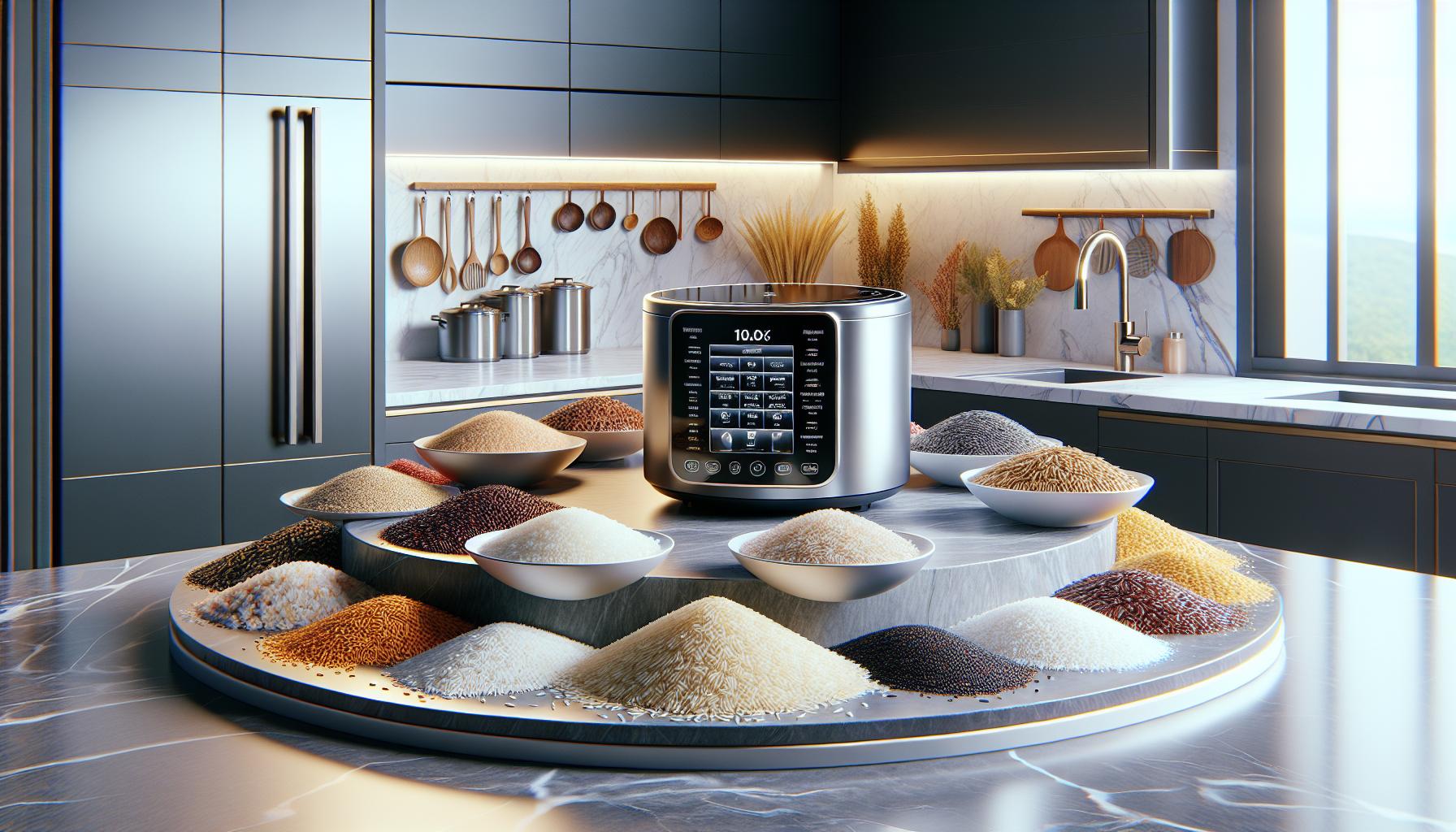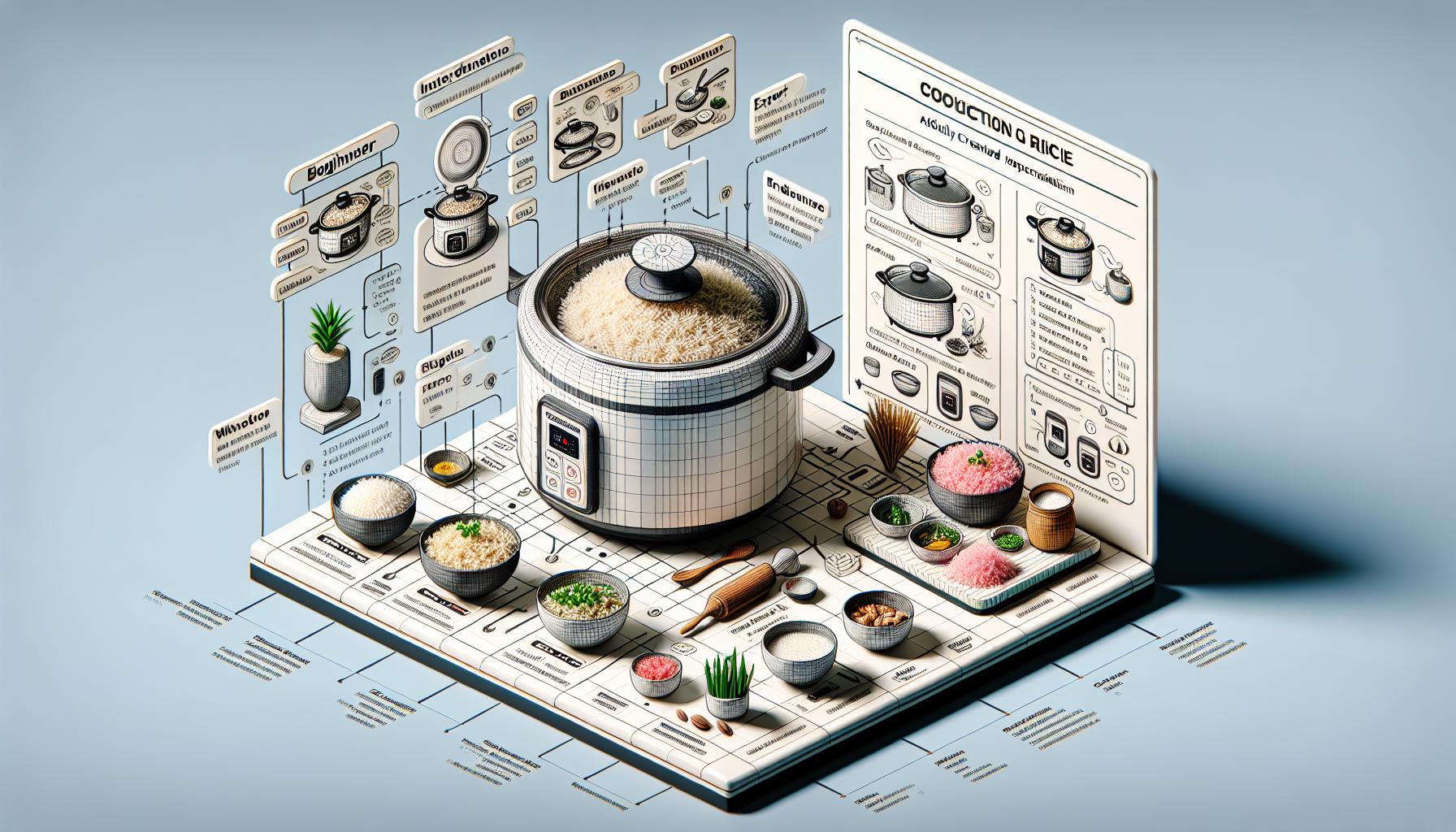So, you’re all set to whip up a delicious batch of rice in your trusty induction rice cooker. Cooking rice to perfection is an art form in itself, and with the right tools and knowledge, we can achieve that fluffy, flavorful result every time. The beauty of using an induction rice cooker lies in its efficiency and precision, making the cooking process a breeze for us busy bees.
When it comes to determining the ideal cooking time for rice in an induction rice cooker, factors such as the type of rice, desired texture, and cooker settings all play a crucial role. By understanding these key elements and following a few simple steps, we can ensure that our rice turns out just the way we like it – whether we prefer it soft and sticky or light and fluffy. Let’s dive into the specifics of how long it typically takes to cook rice in an induction rice cooker and master this essential kitchen skill.
Types of Rice That Work Well in an Induction Rice Cooker
When it comes to choosing the right type of rice for your induction rice cooker, selecting the appropriate variety is crucial for achieving the perfect texture and flavor. Here are some popular types of rice that work exceptionally well in induction rice cookers:
For Beginners: Mastering the Basics:
- Short Grain White Rice: Ideal for those new to cooking rice, as it’s easy to cook and has a sticky texture that holds well.
- Medium Grain Brown Rice: A healthier option with a nuttier taste, perfect for beginners looking to explore different rice varieties.
- Jasmine Rice: Known for its fragrant aroma and slightly sticky texture, making it a beginner-friendly choice for various dishes.
For Intermediate Cooks: Enhancing Your Dish
- Basmati Rice: Aromatic long-grain rice that offers a fluffy texture, suitable for those looking to elevate their rice dishes.
- Arborio Rice: Perfect for creamy risottos, this short-grain rice absorbs flavors exceptionally well, adding depth to dishes.
- Black Rice: Packed with antioxidants and a slightly sweet flavor, ideal for intermediate cooks wanting to experiment with unique rice varieties.
- Sushi Rice: Expert cooks can explore the art of sushi-making with this short-grain rice, known for its sticky and seasoned nature.
- Wild Rice: Not technically rice but a nutrient-dense grain, great for expert chefs looking to add complexity and a chewy texture to their dishes.
- Forbidden Black Rice: A gourmet option with a rich, nutty flavor and striking appearance, offering experts a unique culinary experience.
By choosing the right type of rice for your induction rice cooker based on your skill level and desired outcome, you can enhance the flavors and textures of your dishes effortlessly. Experiment with different varieties to discover your favorites and elevate your cooking to new heights.
Factors Affecting Cooking Time in an Induction Rice Cooker

When using an induction rice cooker, various factors can influence the cooking time required to achieve the perfect batch of rice. Understanding these factors will help you master the art of cooking rice efficiently and consistently.
For Beginners: Getting Started Right
- Rice Type: Different types of rice may require varying cooking times. Start with white rice for quick and easy preparation.
- Water Ratio: The amount of water used can affect cooking time. Follow the recommended rice-to-water ratio for optimal results.
- Induction Settings: Familiarize yourself with the induction cooker settings to ensure the rice cooks evenly and thoroughly.
For Intermediate Cooks: Refining Your Skills
- Grain Variety: Experiment with brown rice or wild rice, which have longer cooking times compared to white rice.
- Pre-Soaking: Pre-soaking certain rice varieties can reduce cooking time and improve the texture of the grains.
- Temperature Control: Adjust the temperature settings on the rice cooker to fine-tune the cooking process based on the type of rice being used.
- Pressure Cooking: Utilize pressure cooking settings on advanced rice cookers for faster cooking times without compromising on flavor.
- Rice Quality: High-quality rice may require shorter cooking times due to its freshness and moisture content.
- Customized Settings: Explore custom settings on induction rice cookers to tailor the cooking process according to your preferences.
As you gain experience and experiment with different rice types and cooking methods, you’ll develop a keen understanding of how these factors interact to determine optimal cooking times in your induction rice cooker. Continuing to refine your techniques will lead to consistently delicious results with every batch of rice you prepare.
Recommended Cooking Time for Different Types of Rice
When it comes to using an induction rice cooker, the cooking time can vary depending on the type of rice being prepared. To achieve perfectly cooked rice every time, it’s important to consider the recommended cooking times for different varieties of rice. Whether you’re a beginner, intermediate cook, or an expert chef, adjusting the cooking time according to the type of rice you’re using can make a significant difference in the final outcome of your dish. Below, we provide detailed recommendations for each experience level:
For Beginners: Getting Started on the Right Foot
- Basmati Rice: Typically takes around 20-25 minutes to cook.
- Jasmine Rice: Cooks in approximately 15-20 minutes.
- Long-Grain White Rice: Cook for about 15-20 minutes.
- Short-Grain White Rice: Requires around 20-25 minutes of cooking time.
- Brown Rice: Cooks for approximately 30-40 minutes.
- Wild Rice: Generally takes 45-50 minutes to cook.
For Intermediate Cooks: Enhancing Your Culinary Skills
- Arborio Rice: Cook for 18-20 minutes for that perfect risotto texture.
- Black Rice: Typically cooks in 30-35 minutes.
- Red Rice: Requires around 25-30 minutes of cooking time.
- Sushi Rice: Cook for 20-25 minutes for ideal sushi texture.
- Forbidden Rice: Generally takes 30-35 minutes to cook.
- Sticky Rice: Cooks in approximately 25-30 minutes.
- Basmati Rice (Pressure Cooking): Can be cooked in just 5-6 minutes using a pressure cooking setting.
- Customized Settings: Experiment with different settings based on rice type, water ratio, and personal preferences to achieve precise results.
- High-Altitude Cooking: Adjust cooking times for specific types of rice when cooking at high altitudes for optimal results.
Remember, adjusting cooking times according to the type of rice being used is crucial to achieving perfectly cooked rice in an induction rice cooker. By mastering these cooking times, you can elevate your culinary skills and experience a world of diverse flavors with every batch of rice you prepare.
Adjusting Cooking Time for Desired Texture
When using an induction rice cooker, adjusting the cooking time for desired texture is key to achieving perfect rice. Let’s dive into tailored recommendations for different experience levels:
For Beginners: Mastering the Basics
- Start with white rice varieties for shorter cooking times, around 15-25 minutes.
- Aim for a fluffy and slightly sticky texture by following the basic recommended times.
- Experiment with jasmine or short-grain rice for subtle variations in texture.
For Intermediate Cooks: Enhancing Your Dish
- Dive into specific rice types like Arborio, Black, and Sushi rice for varying textures and flavors.
- Adjust cooking times to achieve creamy risotto, sticky sushi rice, or al dente black rice with precision.
- Explore custom settings on your induction rice cooker to fine-tune textures.
- Take on Basmati rice with pressure cooking for fluffy grains with separate texture.
- Experiment with wild rice blends for nutty flavors and adjust cooking times for optimal results.
- Customize settings based on personal preferences to elevate your rice dishes to gourmet levels.
Mastering the cooking time for rice in an induction cooker is a foundational skill that opens doors to a world of culinary possibilities. Whether you’re a beginner looking to achieve the perfect fluffy rice or an expert aiming for gourmet textures, adjusting the cooking time according to desired outcomes is the key ingredient to culinary success.
Tips for Perfectly Cooked Rice in an Induction Rice Cooker

For Beginners: Mastering the Basics
- Start with white rice varieties for easier cooking.
- Rinse the rice before cooking to remove excess starch.
- Follow the 1:1.5 rice-to-water ratio for fluffy results.
- Use the white rice setting on your cooker for simplicity.
- Let the rice sit for a few minutes after cooking for best texture.
For Intermediate Cooks: Enhancing Your Dish
- Experiment with specific rice types like Arborio or Sushi rice.
- Try using coconut milk or broth instead of water for added flavor.
- Utilize the sushi rice setting for sticky sushi rice perfection.
- Add seasonings or spices while cooking for a flavorful twist.
- Consider mixing different rice varieties for unique textures and tastes.
- Explore pressure cooking for fragrant Basmati rice.
- Customize settings like temperature and cooking time for gourmet results.
- Infuse rice with herbs, citrus zest, or toasted nuts for a sophisticated touch.
- Experiment with different cooking methods like sautéing the rice before cooking.
- Master the art of perfectly al dente or creamy risotto by adjusting settings accordingly.
| Beginners | Intermediate | Experts |
|---|---|---|
| 1:1.5 rice-to-water ratio | Experiment with specific rice types | Pressure cooking for Basmati rice |
| White rice setting | Coconut milk or broth for flavor | Customize settings for gourmet results |
| Let rice sit after cooking | Sushi rice setting | Infuse rice with herbs or citrus zest |
Conclusion
In wrapping up, we’ve delved into the world of cooking rice in an induction rice cooker, catering to all skill levels. From beginner to expert, there are tailored suggestions to enhance your rice cooking experience. Whether you’re starting with white rice or exploring gourmet options like Basmati, the possibilities are endless. Experimenting with different liquids, rice varieties, and seasonings can elevate your dishes to new heights. Remember, adjusting settings and adding personal touches like herbs or citrus zest can make all the difference. With these tips in mind, you’re well-equipped to create delicious rice dishes that will impress even the most discerning palates.


